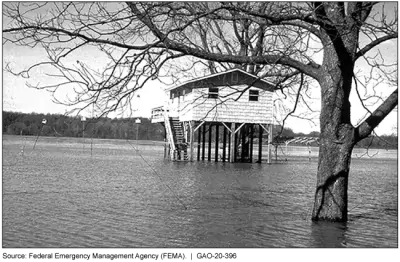The Wave of Concerns Facing the National Flood Insurance Program
Congress created the National Flood Insurance Program in 1968 to protect homeowners and alleviate taxpayers’ exposure to flood losses. However, the growing magnitude of major flood events, combined with attempts to keep homeowners’ policy rates affordable, threaten the program’s solvency and expose taxpayers to losses.
Finding common ground on flood insurance reform has been difficult.
On Sept. 30, the National Flood Insurance Program (NFIP) was reauthorized for another year, allowing it to continue offering flood coverage to America’s homeowners. However, much needed reform has yet to materialize, leaving the nation’s taxpayers exposed as the program continues to take on more debt.
Today’s WatchBlog looks at the nation’s flood insurance program, and what could be done to fix it.
Image

How we got here
Congress created NFIP with 2 competing goals: keeping flood insurance affordable and keeping the program fiscally solvent. However, a historical focus on affordability has come at the expense of solvency.
In particular, Congress has required the program to charge discounted premium rates to many policyholders, even though these rates do not reflect the full risk of flood losses. This has led to a shortfall in revenue, and NFIP has not had sufficient funds to pay claims. Additionally, because Congress has not appropriated funding to pay for this shortfall, NFIP has borrowed from the Treasury (i.e., taxpayers) to cover it—about $36.5 billion since 2005. For these reasons, we placed NFIP on our High Risk List in 2006.
Efforts to mitigate flood risk
The Federal Emergency Management Agency (FEMA) administers three grant programs that fund efforts to mitigate the flood risk of properties insured by NFIP. These programs funded $5.4 billion (adjusted for inflation) in projects from 1989 to 2018 to help states and localities mitigate more than 57,000 properties. While these efforts have reduced flood risk, NFIP’s debt has continued to grow because premium rates do not fully reflect the flood risk of its insured properties.
Image

How we fix it
Our April 2017 report outlined a roadmap for comprehensive reform that could improve the program’s solvency and better protect Americans from flood risk. One of the main challenges with reform is trying to bridge the seemingly unbridgeable divide between affordability and solvency. We found that full-risk premium rates for all policies, with appropriated means-based subsidies, could help address this issue because:
- Full-risk premium rates would remove subsidies from those who don’t need them—helping improve solvency—and more accurately signal the true flood risk to property owners.
- Means-based subsidies would ensure that property owners who need help would get it.
- Having Congress explicitly appropriate for the subsidies would make the true cost of the subsidy transparent to taxpayers.
While comprehensive NFIP reform should address other issues we’ve identified, such as encouraging more Americans to purchase flood insurance, focusing on the affordability/solvency trade-off could be an important first step to putting NFIP on a sustainable path, protecting both policyholders and taxpayers.
Want to learn more about our recent work on the National Flood Insurance Program? In June, we reported on FEMA’s efforts to purchase properties in areas prone to flooding in order to reduce the insurance program’s financial challenges. In May, we reported on how communities are implementing FEMA requirements on floodplain management and post-disaster rebuilding efforts.
- Comments on GAO’s WatchBlog? Contact blog@gao.gov.




